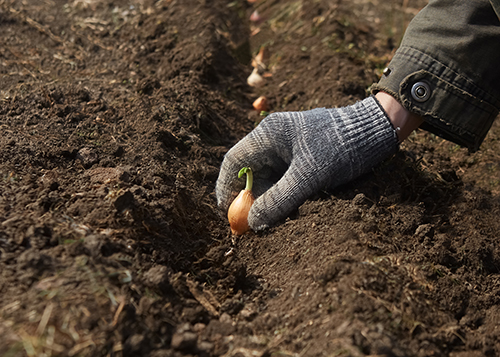Onion Set Growing Guide
Mar 13, 2023

Seed and vegetable sets have arrived at many Co-ops for the spring planting season. A favorite of many gardeners for this time of year are onions. Onion sets are simply small bulbs that were grown from seed in the previous season and harvested as an immature bulb to be planted in the following season.
Have you ever wondered why onion sets are so much more popular than planting from seeds? For one, they establish quickly and are easier to plant. Because of their hardiness, sets have a higher success rate than direct-sown seeds and are better suited for our state’s climate. Furthermore, they can be harvested up to 40 to 60 days before onions that are started from seeds.
In general, onion sets mature in about 14 weeks. Because onion sets are tolerant of light frosts, they can be put in the ground as soon as temperatures warm up to 48 degrees. In general, sets should be planted as early as possible for maximum development before harvest.
Many gardeners make the mistake of choosing the largest onion sets they can find when they should actually be picking the smallest sets instead. Large onion sets tend to produce stiff necks and go to flower sooner than smaller sets, so in this case, bigger does not mean better. Instead, look for onion sets that are approximately ¾ inch in diameter.
Once you have picked up your onion sets from your local Co-op, it’s time to put them in the ground. Onions grow best in direct sunlight, so choose a location where they will not be shaded by other plants. The soil should also be well-draining and loose to foster bulb development, and nitrogen fertilizer may be added at planting time.
Bury onion sets 2 to 6 inches apart, gently pressing them 1 to 2 inches into the soil with the point end up. Continue to fertilize with nitrogen every few weeks until the onions push the soil away and start the bulbing process. Do not try to re-cover emerging onions. Generally, rainwater is sufficient for onions, although if you want sweeter onions, water more.
Spring-planted onions tend to be ready for harvesting by mid-summer. When they start to mature, their foliage will become yellow and begin to fall over. At this point, loosen the soil around the bulbs to encourage drying. When the tops are brown, wait for dry weather and then pull the onions. Leave them on dry ground or in a protected place such as a garage or barn to cure for a few days before storing.
While there are many different onion varieties to choose from, you can rest assured that your local Co-op stocks the varieties that are most suitable for your specific area. Visit us for other gardening essentials as well, such as tools and fertilizer, to help you have a successful growing season. Find the nearest location here.
For more content like this, check out the latest issue of The Cooperator.
Have you ever wondered why onion sets are so much more popular than planting from seeds? For one, they establish quickly and are easier to plant. Because of their hardiness, sets have a higher success rate than direct-sown seeds and are better suited for our state’s climate. Furthermore, they can be harvested up to 40 to 60 days before onions that are started from seeds.
In general, onion sets mature in about 14 weeks. Because onion sets are tolerant of light frosts, they can be put in the ground as soon as temperatures warm up to 48 degrees. In general, sets should be planted as early as possible for maximum development before harvest.
Many gardeners make the mistake of choosing the largest onion sets they can find when they should actually be picking the smallest sets instead. Large onion sets tend to produce stiff necks and go to flower sooner than smaller sets, so in this case, bigger does not mean better. Instead, look for onion sets that are approximately ¾ inch in diameter.
Once you have picked up your onion sets from your local Co-op, it’s time to put them in the ground. Onions grow best in direct sunlight, so choose a location where they will not be shaded by other plants. The soil should also be well-draining and loose to foster bulb development, and nitrogen fertilizer may be added at planting time.
Bury onion sets 2 to 6 inches apart, gently pressing them 1 to 2 inches into the soil with the point end up. Continue to fertilize with nitrogen every few weeks until the onions push the soil away and start the bulbing process. Do not try to re-cover emerging onions. Generally, rainwater is sufficient for onions, although if you want sweeter onions, water more.
Spring-planted onions tend to be ready for harvesting by mid-summer. When they start to mature, their foliage will become yellow and begin to fall over. At this point, loosen the soil around the bulbs to encourage drying. When the tops are brown, wait for dry weather and then pull the onions. Leave them on dry ground or in a protected place such as a garage or barn to cure for a few days before storing.
While there are many different onion varieties to choose from, you can rest assured that your local Co-op stocks the varieties that are most suitable for your specific area. Visit us for other gardening essentials as well, such as tools and fertilizer, to help you have a successful growing season. Find the nearest location here.
For more content like this, check out the latest issue of The Cooperator.